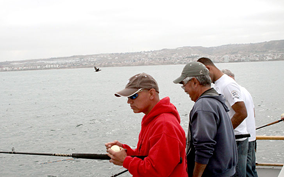
Trolling can be an effective method of catching almost all varieties of fish, provided that you know where they are schooled and their depth. Once the fish have been located, the challenge then is to position the lure at the desired depth. This article discusses some of the variables that need to be managed to achieve and maintain the target depth.
Every lure is designed for a specific purpose and performance range. Most lure manufacturers provide a dive chart that illustrates the depth that a lure will attain for a particular lead length and trolling speed. The recommended trolling speed is between 2 and 3 miles per hour and needs to held constant. Varying trolling speed can have a significant negative impact on your ability to achieve and maintain the target depth. Lures that are designed to dive will go deeper when the trolling speed is increased. The converse is true if the trolling speed is reduced. If a thick line is being used, an increase in speed will cause the lure to lose depth because of an increase in line resistance.
Lead length, which is the amount of line between the pole and the lure/diving device, is the most important variable when it comes to achieving the desired depth, and it is also the easiest to manipulate. The ideal situation is to have a lure or diving device that allows the target depth to be achieved with a short to moderate lead length. Long lead lengths are undesirable for a couple of reasons. First, divers that float at rest will have difficulty maintaining depth. Even if the target depth can be achieved and maintained, hook sets can be impaired due to line stretch (especially monofilament) and the longer length provides more opportunity for fish to escape.
Once you know the ideal lead length, the next question is how to determine the amount of line that has been spooled out. Electronic line counters in which the line travels through the device are available. These counters attach to most rods and can be quickly stowed so as not to interfere with retrieval. Reels are also available with built-in mechanical counters. These counters cannot account for changes in spool diameter, potentially resulting in a significant error if the reel is over or under loaded with line. Most reels, however, are fairly accurate when loaded to capacity as directed by the reel manufacturer. A third option is to utilized colored lead line. Every ten feet of the line is a difference color, so you simply count the number of colors that have been deployed.
Several other factors could also affect your ability to achieve and maintain the target depth. Weeds, debris and water organisms that accumulate on the line can significantly reduce the maximum running depth due to line resistance. If the trolling motor is not tracking directly with or against the waves, because of surface currents or cutting across waves, as much as 10% of the maximum depth could be shaved. Finally, wave motion that causes the boat and fishing line to rise and fall means the best you can hope to achieve is an ‘average' running depth.
--
The author is a retired software engineer who has always had an interest in fishing. Following retirement, developed a website that sells freshwater trolling motors and trolling motor accessories. The site, http://www.articletrader.com
